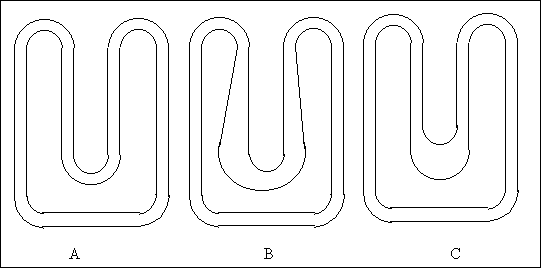
Tracks without Bridges
A track with no bridges, and the lanes a constant distance apart, will have the outside lane longer than the inside lane. With equal cars and drivers, the outside lane will (with very few exceptions) take longer to lap than the inside lane. The more lanes a track has, the more the difference will be. However, it's easier to build a track without a bridge, so it's well worth considering particularly for small tracks.

In A above, the inside lane is obviously shorter than the outside one. Here are some design ideas for evening things up. Pick a corner where the "outside" lane is on the inside (like the corners in the middle above) and make the "inside" lane longer as in B and C above. These are just a simple examples, but the same ideas can be applied to more complicated track layouts.
How much do you lengthen the "inside" lane to even up the lap times? There is no reliable way of predicting this exactly how much. To calculate the difference in lane length when the lanes are a constant distance apart is simple (2 pi times the lane spacing) so for example a 2 lane track with 10 cm. lane spacing will have the outside lane 62.8 cm shorter than the outside one. If the inside lane were made that much longer it would be slower than the outside lane because it is predominantly going round tighter corners so the car will be traveling slower in most corners. Something like half the distance would probably even up the lanes on most designs, so taking the above example extending the "inside" lane by 30 to 35 cm would be about right. Even when tracks have bridges, there are almost always some lanes quicker than others (that's one reason for segmented racing) - if you want to make the lanes exactly the same speed be prepared for some trial and error modifications.
In the very unusual case of the outside lane being quicker, similar methods can be used to even up the lanes times. For example, the right angle bends at the bottom of diagram A are a good place to either slow down the outside lane or speed up the inside lane. To slow the outside lane, extend the straights on that lane and make a smaller radius right angle bend to join them. To speed up the inside lane, shorten the straights on that lane and make a larger radius right angle bend to join them,
Chris Frost